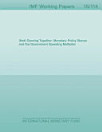Tax Buoyancy in OECD Countries
Jun 2014 · International Monetary Fund
Ebook
18
Pages
reportRatings and reviews aren’t verified Learn More
About this ebook
By how much will faster economic growth boost government revenue? This paper estimates short- and long-run tax buoyancy in OECD countries between 1965 and 2012. We find that, for aggregate tax revenues, short-run tax buoyancy does not significantly differ from one in the majority of countries; yet, it has increased since the late 1980s so that tax systems have generally become better automatic stabilizers. Long-run buoyancy exceeds one in about half of the OECD countries, implying that GDP growth has helped improve structural fiscal deficit ratios. Corporate taxes are by far the most buoyant, while excises and property taxes are the least buoyant. For personal income taxes and social contributions, short- and long-run buoyancies have declined since the late 1980s and have, on average, become lower than one.
Rate this ebook
Tell us what you think.
Reading information
Smartphones and tablets
Install the Google Play Books app for Android and iPad/iPhone. It syncs automatically with your account and allows you to read online or offline wherever you are.
Laptops and computers
You can listen to audiobooks purchased on Google Play using your computer's web browser.
eReaders and other devices
To read on e-ink devices like Kobo eReaders, you'll need to download a file and transfer it to your device. Follow the detailed Help Center instructions to transfer the files to supported eReaders.




